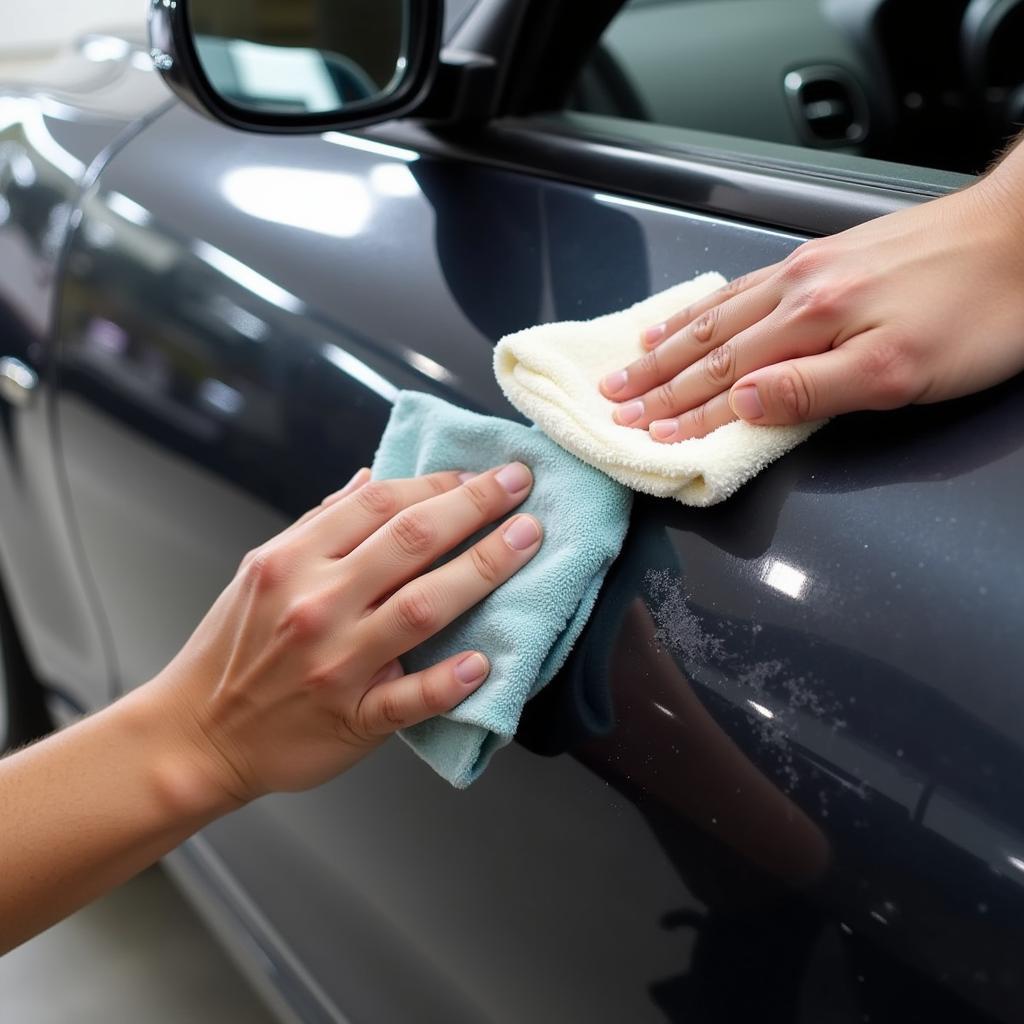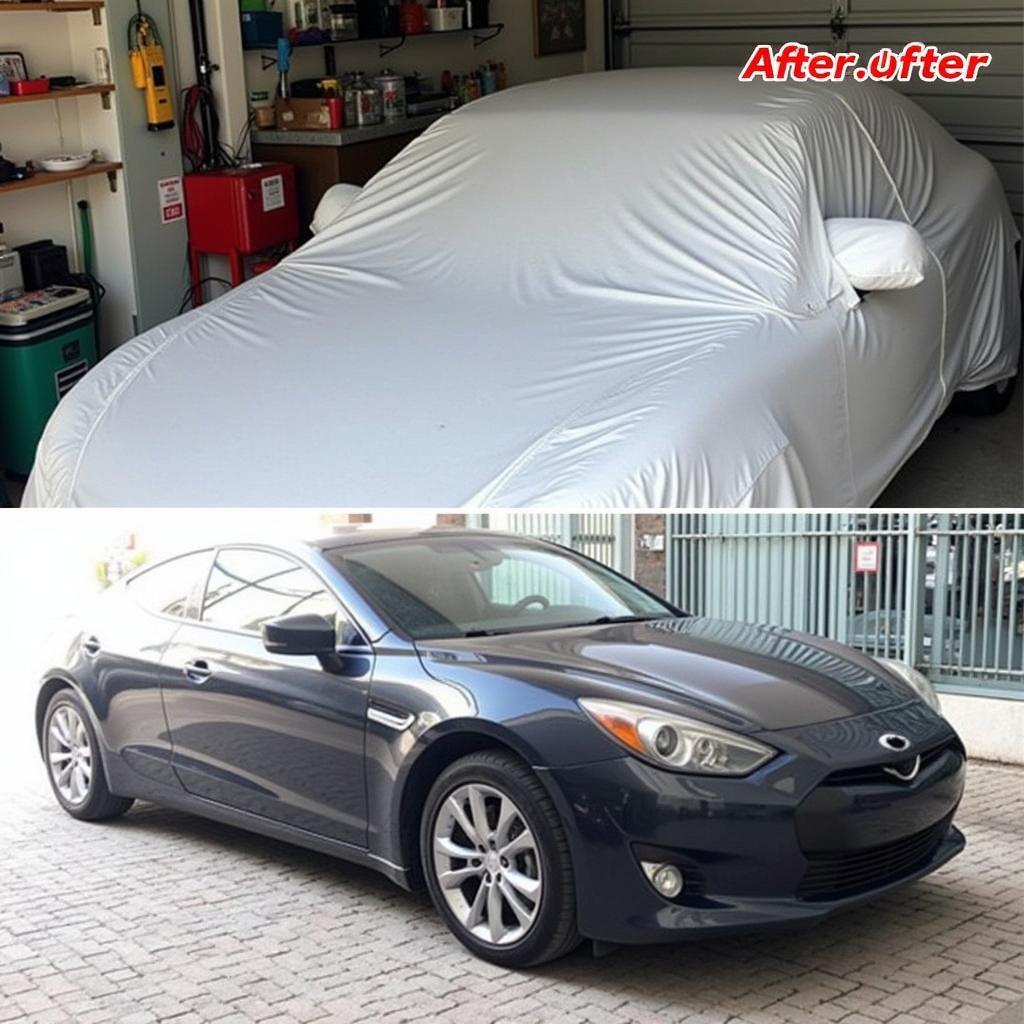Dealing with minor car scratches can be frustrating. Whether it’s a rogue shopping cart, a careless key swipe, or a low-hanging branch, these little blemishes can detract from your car’s appearance. Fortunately, fixing little scratches on car paintwork is often easier than you think. This comprehensive guide will walk you through the process, from assessing the damage to achieving a professional-looking repair. Learn how to save money and restore your car’s pristine finish.
Assessing the Scratch: How Deep Does it Go?
Before you grab your polishing compound, it’s crucial to determine the severity of the scratch. This will dictate the appropriate repair method. There are generally three levels of car scratches:
- Clear Coat Scratches: These are the most superficial, affecting only the clear coat – the protective layer on top of the paint. They often appear as light, hazy marks and are the easiest to fix.
- Base Coat Scratches: These penetrate the color layer of the paint, revealing the primer underneath. They’re more noticeable and require a bit more effort to repair.
- Primer/Metal Scratches: These are the deepest type, reaching down to the metal body of the car. They require more extensive repairs and may even need professional attention to prevent rust.
Knowing how to differentiate between these scratch types is the first step to a successful DIY fix. A simple way to check is to run your fingernail across the scratch. If your nail catches, it’s likely more than a clear coat scratch and might require more than just a simple polish.
DIY Solutions: Fix Little Scratches on Car Like a Pro
For minor clear coat scratches, you can often achieve excellent results with readily available products. Here are some effective methods:
- Car Wash and Dry: Thoroughly wash and dry the affected area to remove any dirt or debris that could further scratch the paint during the repair process.
- Rubbing Compound: Apply a small amount of rubbing compound to a microfiber cloth and gently rub it onto the scratch using circular motions. how to fix little scratches on car provides detailed instructions on using rubbing compound effectively.
- Polishing Compound: After the rubbing compound, follow up with a polishing compound to restore shine and remove any swirl marks left by the rubbing compound.
- Wax: Apply a coat of wax to protect the repaired area and give your car a showroom finish.
 Applying Rubbing Compound to Car Scratch
Applying Rubbing Compound to Car Scratch
For slightly deeper scratches that reach the base coat, a touch-up paint pen might be necessary. Ensure you choose the correct color code for your car’s paint.
When to Call a Professional
While many minor scratches can be tackled with DIY methods, some situations warrant professional help. Deep scratches that expose the primer or metal should be addressed by a professional to prevent rust and ensure a proper repair. If you’re unsure about tackling the repair yourself, it’s always best to seek expert advice. how to fix little scratches on your car offers further guidance on when professional intervention is recommended.
Preventing Future Scratches: Proactive Car Care
Preventing scratches is always better than fixing them. Here are a few tips:
- Regular Washing and Waxing: A clean and waxed car is less susceptible to scratches.
- Careful Parking: Park away from shopping carts and other potential hazards.
- Use a Car Cover: Protect your car from the elements and accidental scratches with a car cover.
“Regular maintenance is key to keeping your car looking its best,” says renowned auto detailer, Michael Davis. “A little preventative care can save you a lot of time and money in the long run.”
 Preventing Car Scratches – Using a Car Cover
Preventing Car Scratches – Using a Car Cover
Conclusion: Keep Your Car Looking Its Best
Fixing little scratches on car paintwork is often a manageable DIY project. By assessing the damage correctly and using the right techniques, you can restore your car’s appearance and protect its value. However, knowing when to seek professional help is just as important. Remember, proactive care is the best way to avoid scratches altogether. For any further assistance, feel free to connect with us at AutoTipPro. Our team is ready to assist you with all your car maintenance needs. Call us at +1 (641) 206-8880 or visit our office at 500 N St Mary’s St, San Antonio, TX 78205, United States.
“Addressing scratches promptly prevents further damage and maintains your car’s value,” advises Sarah Miller, a leading automotive paint specialist.
FAQ
- Can I use toothpaste to fix car scratches? While toothpaste might seem like a quick fix, it’s not recommended for car scratches. It can be abrasive and may cause more harm than good.
- How much does it cost to professionally fix car scratches? The cost varies depending on the severity and location of the scratches. Minor scratches can often be repaired for a reasonable price.
- What is the best rubbing compound for car scratches? There are many excellent rubbing compounds available. Consult with a car care specialist to determine the best product for your car’s paint.
- Can I fix deep scratches myself? While you can attempt to repair deep scratches, it’s often best to leave it to professionals to avoid further damage and ensure a proper repair. fix stone chips in car paint offers specific guidance for this type of damage.
- How can I prevent scratches from car washes? Opt for touchless car washes or hand wash your car using the proper techniques and materials.
- Does car insurance cover scratch repairs? Coverage for scratch repairs depends on your insurance policy.
- Can I fix scratches on a leased car? Consult your lease agreement for guidelines on repairing scratches on a leased vehicle. fix my leather car seat provides information on repairing another common type of car damage. You might also find does apple care fix back glass helpful if you are dealing with a cracked phone screen.




Leave a Reply